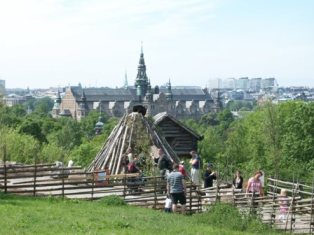A Trip Through Time

Europe can be a facinating place for Americans. I have been traveling this continent with my parents since I was a child, and I have always been struck by the sheer age of things here. Castles and cathedrals older than our country. Farmhouses that have withstood famines, plagues, and wars. Stone roads and sturdy bridges that have seen the passing feet of soldiers on their way to the Holy Land, saints as well as sinners. These things have not only withstood the test of time, but continue to be used by people today as they were thousands of years ago. In America, we like to put our relics and antiques behind glass, with alarms to warn us if even a speck of dust gets too close. Abraham's cabin becomes a tourist trap and plantations become museums. While we preserve our history, Europe relies on thiers. The foundations of European countries, therefore, seem to be more evident to the everyday traveller simply because they are part of everyday life. Houses that have been around since the 1300s are still home to modern city dwellers. They don't tear them down to build McMansions. I think that is part of what I like about Europe. Everything seems to live and breathe history, culture, and tradition, all topped with an embrace of the modern.
This photo was taken from a vantage point on top of a hill on one of the islands of the Stockholm archipelego. This island is famous for being one of the oddest tourist attractions in Europe. On this island sits the National History Museum, a museum devoted solely to the children's character Pippi Longstockings, and a nautical museum that houses a recovered wooden Viking ship. There is also an amusement park as well as the city's botanical gardens. However, my fellow interns and I were not drawn to the island for these things. This weekend was a 5 day weekend. Thursday was Ascension Day, Monday was National Day, and Friday was what they lovingly term Sandwich Day in Sweden because it is a vacation day that exists solely because of its location between holidays. I approve of this idea whole heartedly, as it would seem silly to come back into work for one day. Anyway, in honor of National Day, my friends and I decided to do the most national/toursity thing we could think of. We decided to visit the outdoor history museum/zoon called Skansen.
The outdoor history museum concept should be familiar to anyone from William and Mary. Like Williamsburg, there are historical interpreters, handicrafts shops, and many tourists. However, Skansen takes it one step further in that they are also a zoo. Maybe Willliamsburg should also have pens for wolves, bears, and various Swedish wildlife. Then again, maybe not. It turns out that most of the Swedish animals are nocturnal, which makes sense for those who live in a country where the sun doesn't rise for more than a few hours a day for most of the very cold and snowy year. My friends and I mainly had to make do with the odd moose and some fairly typical farm animals. Nestled among that fauna, however, was some very interesting Swedish history. Skansen is comprised of old buildings dating from different periods in Sweden's history, all picked up and relocated to Stockholm for inclusion in the museum. The island is home to the oldest standing wooden house in Sweden, some very charming farmhouses and school houses from the early 1920's, and a few Viking-worthy huts placed on stilts so they don't get trapped inside by the snow dirfts which were apparently abot 8 feet tall. That's tall even for a Viking.
However, the photo above shows one of my favorite views of the city. Skansen sits on a tall hill top, so it is a particularly nice spot to stop and take a photo. I love this shot in particular, though, because it so nicely captures the old and new dichotomy of Stockholm and Sweden. In the foreground is an old wooden hut from the far north of the country. It is flanked by the National Musuem, an ornate structure dating from Sweden imperialist era. In the background sits the modern city of Sweden, with its international flavor, traditional charm, and Swedish weather. Stockholm is the capital and the heart of nation that has truly seen it all, and it is home to a people who have lived through hard winters, warm summers, and everything in between. Sweden is particularly interesting because it was not touched by the ravages of the World Wars, so it has maintained its history better than most European cities. My trip to Skansen was one of the highlights of my trip so far because it is not only one of the most beautiful parks I have ever seen, but because it was like taking a trip back in time to see Sweden as it was, as it is, and as it could be.